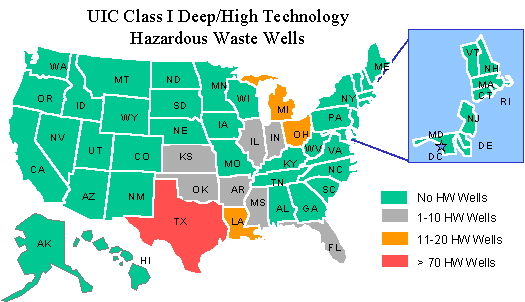|
 |
 |
Deep Wells (Class I)
- EPA has completed and submitted to Congress a study of Class I wells
that describes the current Class I UIC Program, documents past compliance
incidents involving Class I wells, and summarizes studies of human health
risks associated with Class I injection conducted for past regulatory
efforts and policy documentation. Read Class
I Underground Injection Control Program: Study of the Risks Associated
with Class I Underground Injection Wells [PDF file] (EPA 816-R-01-007
/ March 2001).
- Class I injection well facilities dispose of industrial hazardous,
industrial nonhazardous and municipal (non-hazardous) waste.
- There are 272 active Class I injection facilities nationwide. Of
these, 51 are hazardous and 221 are non-hazardous. These 272 facilities
maintain approximately 529 Class I injection wells that are scattered
throughout the US in 19 states. The greatest concentration are located
in the Gulf Coast, Great Lakes, and the Floridian peninsular geographical
regions.
- Class I wells are mainly used in the following industries:
- Petroleum Refining,
- Metal Production,
- Chemical Production,
- Pharmaceutical Production,
- Commercial Disposal,
- Municipal Disposal and
- Food Production.
- Class I injection wells are sited such
that they inject below the lowermost USDW and a confining zone above
an injection zone. Injection zone reservoirs typically range in depth
from 1,700 to over 10,000 feet below the surface.
Hazardous Waste Injection Wells
Injection of hazardous waste into deep wells began in the United States
in the 1960s. At that time, the chemical industry was looking for a safe,
relatively inexpensive method for disposing of high volumes of waste that
could be considered toxic. Technology was borrowed from the oil and gas
industry to develop this new form of disposal.
- There are 163 Class I hazardous waste injection wells located at
51 facilities. Most are found in Texas (78) and Louisiana (18).
Eleven of the facilities are commercial hazardous waste injection facilities.
These are the only facilities that can accept hazardous waste generated
offsite for injection. Ten of them are located in the Gulf Coast region
while one is located in the Great Lakes region.
- Hazardous and Solid Waste Amendments to RCRA made UIC regulations
(1988) more stringent for Class I hazardous wells. This resulted in
strict no-migration standards and a petition approval process for continued
operation of the wells. Of the 51 Class I hazardous waste facilities,
47 have approved no-migration petitions that cover 123 wells. To receive
a no-migration petition the facility must be able to demonstrate that
injected waste will not impact the biosphere (ground water or surface
water) for 10,000 years.

Non-Hazardous Waste Injection Wells
Non-hazardous deep injection wells have to meet all the technical requirements
of hazardous waste wells. These wells inject industrial, low radiation
and municipal wastes. Some States include some mining wells in this group
and require the operators of these wells ot meet all the requirements
of other deep wells.
- There are 366 Class I non-hazardous injection wells nationwide.
While these wells are scattered through 19 states, most of them are
found in the states of Florida (112) and Texas (110).
- Florida is the only state with Class I municipal waste disposal wells
(104).
| You will need Adobe Acrobat Reader to view the Adobe PDF files
on this page. See
EPA's PDF page for more information about getting and using
the free Acrobat Reader. |
|

